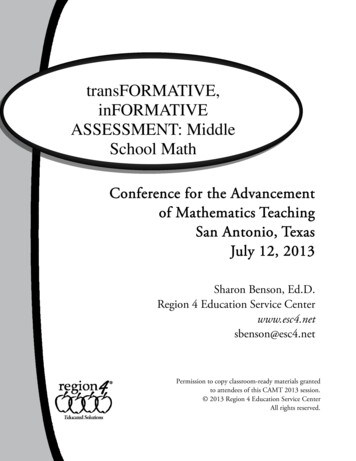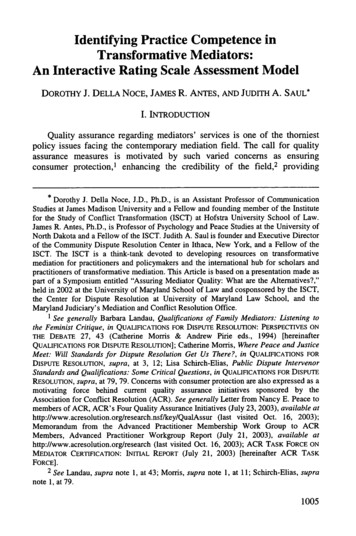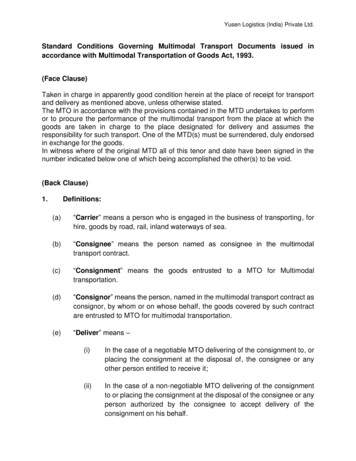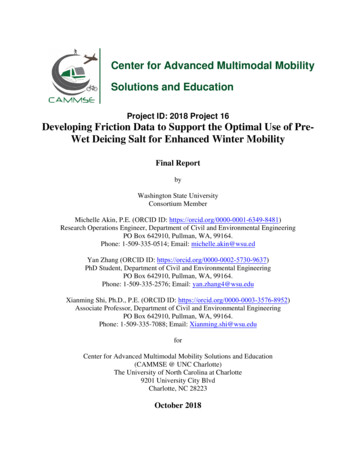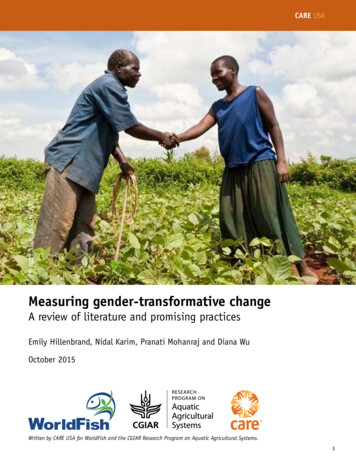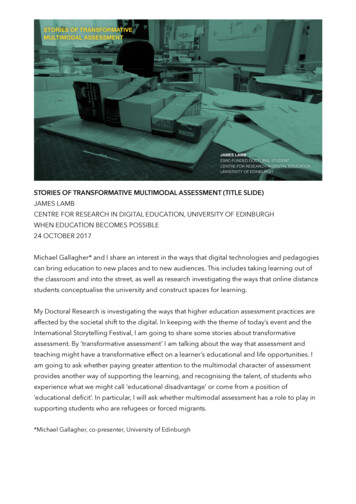
Transcription
STORIES OF TRANSFORMATIVE MULTIMODAL ASSESSMENT (TITLE SLIDE)JAMES LAMBCENTRE FOR RESEARCH IN DIGITAL EDUCATION, UNIVERSITY OF EDINBURGHWHEN EDUCATION BECOMES POSSIBLE24 OCTOBER 2017Michael Gallagher* and I share an interest in the ways that digital technologies and pedagogiescan bring education to new places and to new audiences. This includes taking learning out ofthe classroom and into the street, as well as research investigating the ways that online distancestudents conceptualise the university and construct spaces for learning.My Doctoral Research is investigating the ways that higher education assessment practices areaffected by the societal shift to the digital. In keeping with the theme of today’s event and theInternational Storytelling Festival, I am going to share some stories about transformativeassessment. By ‘transformative assessment’ I am talking about the way that assessment andteaching might have a transformative effect on a learner’s educational and life opportunities. Iam going to ask whether paying greater attention to the multimodal character of assessmentprovides another way of supporting the learning, and recognising the talent, of students whoexperience what we might call ‘educational disadvantage’ or come from a position of‘educational deficit’. In particular, I will ask whether multimodal assessment has a role to play insupporting students who are refugees or forced migrants.*Michael Gallagher, co-presenter, University of Edinburgh
MULTIMODALITY AND DIGITAL EDUCATIONMultimodality is a theory of communication which recognises that the communication ofmeaning takes place in ways beyond language in its different forms.Perhaps a useful way of thinking about multimodality is through the example of assessmentitself. Those of us working in the Humanities and Social Sciences are well-versed in the essayand dissertation, pieces of work that heavily depend on printed language. Through theseassessment instruments a student’s understanding, knowledge and ability - or whatever theparticular interests of the assignment might be - are evaluated through words on page orscreen. We might call this ‘monomodal’ assessment in the way that the marker and theassessment criteria are concerned with the ‘written mode’.To offer a contrast, after my presentation today I will walk over to School of Architecture and, if Istep into the design studios, will see examples of richly multimodal assessment, where studentsare conveying ideas through a combination of different modes: image, sound, language andbeyond.Over the last fifteen years there has been a growing critical interest in the relationship betweenmultimodality and pedagogy, prompted by the increasingly digital nature of education andsociety more generally. It’s not that multimodal communication depends on technology,however digital learning spaces, social media and digital devices particularly encourage theconstruction and consumption of content in ways beyond words, and particularly in visual ways.
STORIES OF TRANSFORMATIVE MULTIMODAL ASSESSMENTI am going to share three stories - case studies from the research literature - where theintroduction of a multimodal assignment in place of entirely language-based forms such as theessay, were seen to support the learning and achievement of groups of students coming frombackgrounds of educational disadvantage.In her work around multimodal designs for learning, Arlene Archer describes how encouragingstudents to draw on their repertoire of creative skills had the effect of surfacing talents thatotherwise tended to be missed within formal educational settings. Archer uses the example of‘culture jamming’ where students drew on their own life experiences, literacies andtechnological skills to convey knowledge in ways beyond the more conventional authority of thewritten form. This produced assignments that deftly drew on the potentialities of the digital formto convey knowledge in ways that were simultaneously humorous and scholarly. In this way,Archer’s work is suggestive of the ways that higher education writing centres can become whatshe refers to as ‘transformational learning spaces’ for student from diverse backgrounds.Within this case study, Archer makes the vital point that equality of access extends beyond thematerial to include the symbolic. Equality of experience around assessment is shaped by astudent’s cultural capital, as well as the physical or digital resources upon which they might draw.If we think about this issue in relation to refugee and migrant students in particular, equality ofopportunity isn’t limited to a place within a degree programme and access to the university’sfacilities, but also comes with the recognition that a student newly arrived in our educationsystem might lack the kind of background knowledge taken for granted by others more familiar
with their academic surroundings. We might ask how students with a first language other thanEnglish might immediately be equipped to express themselves in the ways that are implicitaround assessment. As Archer recognises, access can go beyond unfamiliarity with assessmenttask to a more epistemological level, where knowledge and meaning-making is differentlyunderstood and conceptualised across groups.A call that can be heard with some regularity across the literature concerned with multimodalassessment, is that teaching and assessment needs to adapt to reflect the increasingly visual,digital and multimodal meaning-making practices of students outside the classroom. Thispresents the intriguing possibility that if some of our established and overtly language-basedassessment approaches do not always best serve the needs of learners, perhaps an attention tomore social-oriented representational practices might better enable us to recognise talent, andsupport and acknowledge learning.A case study which looks at the experiences of migrant learners in particular is that byStornaiuolo et al. While the central argument of this case study posits multimodality as a way ofrethinking literacy and media in a new digital age, the article begins by reproducing a textmessage from Alana in California as she introduces herself to two other children, one in Indiaand in South Africa, as part of an educational project. The text message is a charming mixture ofemoticons and words as she aims to break to the ice with unseen friends in the far corners of theworld. As Michael will come on to discuss, the mobile phone has a profound importance withinrefugee communities. Further, in the parts of the world from where refugees and forced migranttypically originate, the smartphone far outweighs the desktop computer and laptop as themeans by which access is secured to networked content, whether educational or otherwise.Software companies are increasingly designing first for mobile devices, counter to ourexperience in the UK with our tendency to refer to the ‘mobile equivalent’ of the computermediated or printed educational resource.Pointing to the increasingly digital, visual nature of global society, Nicholas Mirzoeff has pointedto the the trillion-plus photos that are taken annually on mobile devices, a collective response toa world 'too enormous to see but vital to imagine' (2015: 12). Mobile phones have rapidlymoved beyond language-based communication to become devices that enable the productionof images, sounds and words. Whereas the production of videos or the remixing of pictures andsounds were until recently the preserve of those with a high level of technological ownershipand technical sophistication, these opportunities are now in the hands of the millions of learnerswith access to a smartphone.From the research by Stornaiuolo et al we might look to consider how assessment that paysparticular attention to digital literacies and access of refugee learners might better suit theirpotential to demonstrate knowledge and understanding.
For my third story I want to talk about a case study by Denise Newfield and colleagues. Perhapsmore than anyone, Newfield has looked towards multimodality as a way of alleviatingeducational inequality. Set in an English classroom in Soweto, we hear how disaffected youthhave been inspired by assessment exercises that set out to encourage and reward learner’simagination by making linkages between images, words and other resources: what weunderstand as a multimodal approach. The title of the journal article ‘’No Number Can DescribeHow Good It Was': Assessment issues in the multimodal classroom’ articulated the elation ofpreviously disenfranchised students, as they were pushed to draw on their own life experiencesand interests to demonstrate understanding and ability.I think one of the most important arguments that Newfield and her colleagues make is thatintroducing multimodal assessment requires a bigger commitment than simply replacing awritten essay with a video assignment. Assessment isn’t something that is ‘done unto students’but instead needs their investment, alongside that of the teacher. In this way assessment is muchless about judging how the student performs against a set of criteria at the end of the semester,and instead places emphasis on the ‘process’ of composition, in order to take account of thedecisions that were made, the iterations that were gone through, the progress achieved - whatwe might call ‘learning’, in fact.Thinking about these case studies - and similar examples of transformative stories aroundassessment within the research literature - we are drawn to the ways that students with a firstlanguage other than English; coming from adverse social situations; and with diverse prioreducational histories; were newly enable to learn and to demonstrate their talent by assessmentapproaches that looked beyond language and instead placed a greater emphasis onmultimodal meaning-making.
ACCESSING HIGHER EDUCATIONIt can be fruitful to think about these ideas in relation to some of the public statements aroundrefugees and forced migrants. In 2016, Universities Scotland published its Refugees Welcomereport, which sought to ‘ensure that there is an understanding across the HE sector ofentitlements and that any displaced person living in Scotland that wants to access highereducation is not discouraged by the administrative procedures required to gain entry intohigher education.’ Pointing to the transformative nature of higher education, the report called forflexibility in how admission tutors look to evaluate the talent of refugee applicants. There is arecognition here that educational histories, digital literacies and meaning-making practices varyacross different groups of learners. This is also seen where the Refugees Welcome reportsuggests that students should be entitled to submit a ‘portfolio of work’, a tacitacknowledgement that students construct and communicate knowledge in different ways: andpotentially in ways other than we might have conventionally privileged within higher education.Clearly, there is a parallel here between Universities Scotland’s call for sensitivity aroundadmissions processes, and themes from the stories I have described, where assessment hasbeen designed to allow the life situations, digital literacies and talents of learners. Therefore ifwe can apply a nuanced approach to recognise talent at the point of application, can wesimilarly do so when evaluating understanding and ability at the point of assessment? I amcertain this must already be happening. Indeed, I have already described how in someprogrammes multimodal pedagogy is the norm. Multimodality poses the biggest questions forthose disciplines that depend heavily on the authority of the printed word.
CERTAINTIES AND CHANGEIn this presentation I have used three stories of transformative assessment to ask whether agreater attention to the multimodal character of communication within assessment mightpresent ways of supporting the learning of refugees, whilst providing them with alternative waysof demonstrating their understanding and ability.This does not suggest however that this would be appropriate in every situation or that theconventional essay is obsolete. On the contrary, the message in each of the case studies is aboutaligning assessment with the subject matter and the student body’s circumstances.At the same time, I know from my own research, and from experience of teaching on Masterslevels courses that emphasise the multimodal character of meaning-making, that a range ofpotential barriers mean that the developing assessment in the ways described in the casestudies won’t necessarily be straightforward. These include but are not limited to issues aroundresources, staff expertise, pressures of performativity and beyond.Nevertheless, the increasingly digital nature of society and education, combined with theevolving digital literacy practices of our students, presents us with some important questionsthat are relevant to refugee and forced migrant learners, but also I think, to higher educationstudents in general.
I am going to end, then, by drawing attention by repeating questions asked by Gunther Kressand Theo Van Leeuwen who are widely understood to have conceived multimodality as a field ofresearch in itself.Alluding to the significance of thinking about assessment in a changing digital and globalcontext, Johnson and Kress make clear that our challenge is not simply redesigning assessmenttasks, but instead more to think more fundamentally about the changing nature of knowledge.Approaching the issue of multimodal assessment from a different position, Van Leeuwencautions against losing sight of the purpose of teaching, assessment and of the university moregenerally. Counter to the suggestion elsewhere that assessment should evolve to mirror thetechnologies and meaning-making practices that take place outside the classroom, VanLeeuwen instead asks whether our work in universities shouldn’t instead be about nurturing thetalents that cannot otherwise develop autonomously in social settings.We might distil this to a question of whether the tried-and-trusted pedagogies - what Johnstonand Kress and might see as the ‘old certainties’ - that have helped to establish our universitiesand make them attractive to refugee, migrants and other learners - should be shaped bychanges driven by globalisation, digital technologies and the extra-curricular practices ofstudents.What would seem to be at stake then is not simply assessment, but how we conceptualisehigher education itself, when learning is less bound to the practices that take place inside theconfines of the lecture theatre and within the perimeter of the university campus.I wish to thank Elisabetta Adami from the Centre for Translation Studies at the University of Leedsfor kindly offering feedback on an earlier version of this script.
By ‘transformative assessment’ I am talking about the way that assessment and teaching might have a transformative effect on a learner’s educational and life opportunities. I am going to ask whether paying greater attention t
